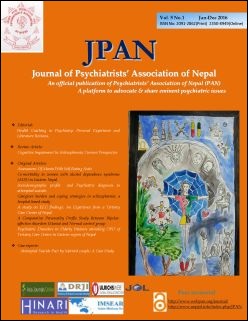Assessment Of Mania With Self Rating Scale
DOI:
https://doi.org/10.3126/jpan.v5i1.18325Keywords:
Mania, Self Rating, Clinician RatingAbstract
Introduction: Patients with mania are generally considered unreliable informants about their illness and most of the mania rating scales are clinician administered. There are few self-rating scales in mania and the utility of which is immense.
Objective: The study was aimed to compare the co-relation between the self-rating scales and clinician rating scales in mania.
Method: Forty-two patients with mania in the tertiary care center of North Indian setting were applied with Clinician Administered Rating Scale for Mania,Altman Self-Rating Mania scale, Hamilton Rating Scale for Depression and Clinical Global Impression Scale at base line and consecutive four weeks. The scores were analyzed for correlation.
Result: The Pearson’s correlation coefficient rho between self rated vs. clinician in the first week scores was 0.368 with p value of <0.05. On the subsequent weeks the rho value progressively increased and became highly significant (p<0.01).
Conclusion: Self-reporting by mania is reliable in looking at the symptoms. Self rating scale is not very reliable when the patient is very severely ill, at least to predict the severity /improvement, but, reliable when the patient improves from very severe illness to moderate or milder degree. The scale can be utilized as an augmentation to the clinical interview.
Downloads
Downloads
Published
How to Cite
Issue
Section
License
This license enables reusers to distribute, remix, adapt, and build upon the material in any medium or format, so long as attribution is given to the creator. The license allows for commercial use.




